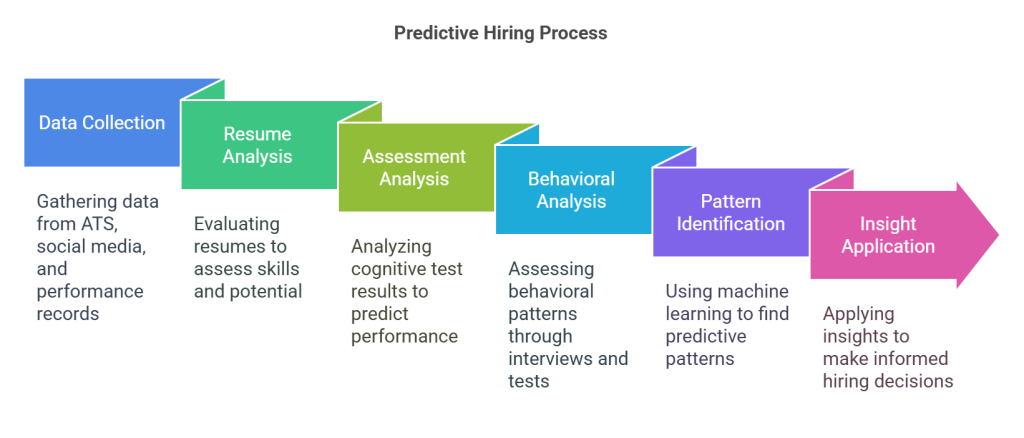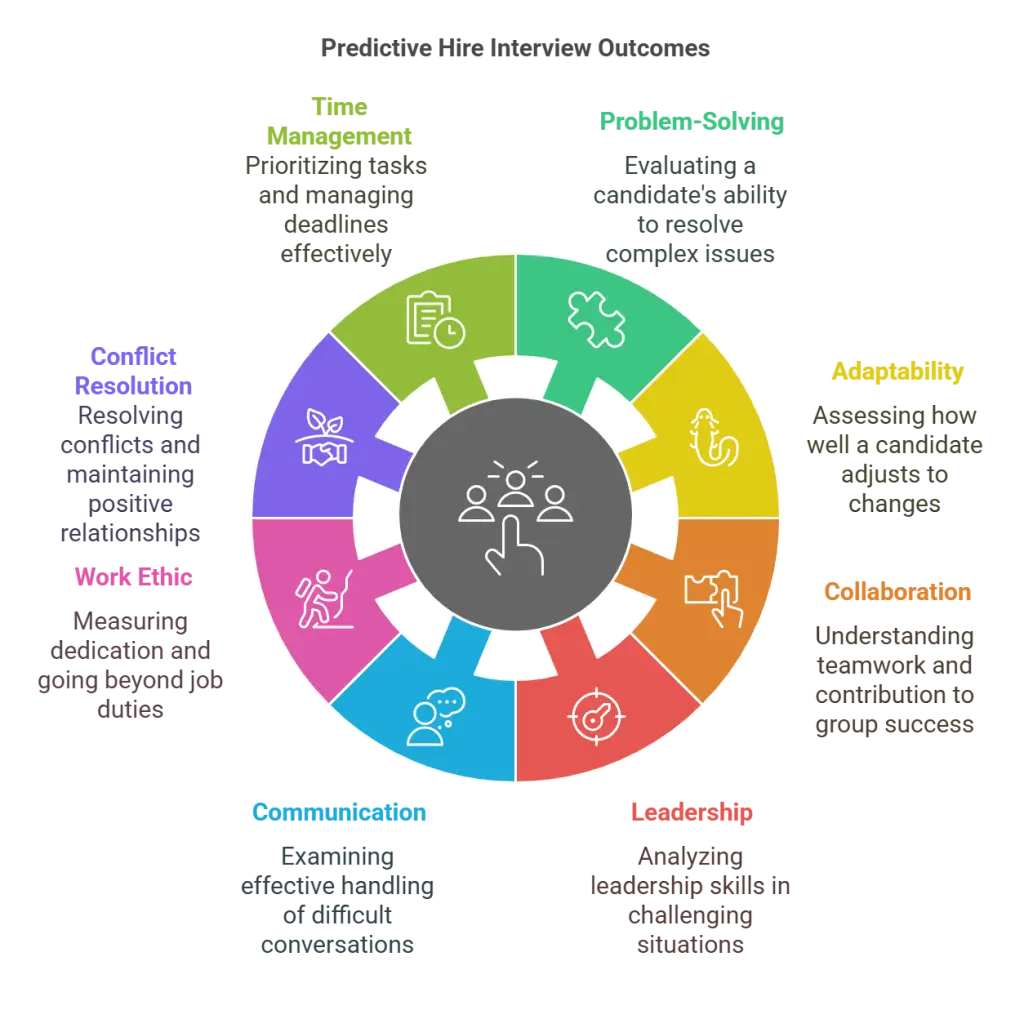Predictive hiring is transforming the way organizations approach talent acquisition. By leveraging data analytics and artificial intelligence, companies can make more informed decisions, streamline their recruitment processes, and improve hiring outcomes. This article explores the concept of predictive hiring, its benefits, and how it can be implemented effectively.
What is Predictive Hiring?
Predictive hiring is a data-driven approach that uses statistical models and algorithms to forecast a candidate's potential success in a role. It goes beyond traditional hiring methods by analyzing a wide range of data points, including resumes, assessments, and behavioral patterns, to predict job performance and cultural fit.
Looking back, this process was traditionally managed through behavioral interviewing, where recruiters and hiring teams utilized specific methodologies to predict the fitness and success of candidates for an open role. Still is the prevailing process in most Companies. However, this approach requires extensive training, practice, documentation, and the actual interview process, which can be time-consuming and resource-intensive. While behavioral interviewing has its merits, it often lacks the precision and consistency offered by data-driven approaches. Additionally, it relies heavily on the subjective judgment of the interviewers, which can introduce bias. As a result, organizations are increasingly turning to predictive hiring techniques to enhance their recruitment efforts.
EXPERT INSIGHT: Generative Artificial Intelligence (GenAI) is undeniably transforming the way we work, heralding both excitement and apprehension. While some perceive GenAI as a mere trend, others are wary of its far-reaching implications. In the realm of HR, GenAI remains an area of intrigue—an evolving tool with immense potential. It prompts critical questions: How can it streamline and enhance our work processes? How can it bolster the success of teams and organizations? And how can it improve employee retention and engagement? Traditionally, these responsibilities rested solely with HR professionals and recruitment firms. Today, however, GenAI offers invaluable support. In this article, we will explore how GenAI can revolutionize the screening and selection process, helping us identify candidates with the greatest potential for success. - Emile Garcia, SHRM-SCP, CHRP, CHRBP
How Does Predictive Hiring Work?
The predictive hiring process starts with collecting data from various sources, such as applicant tracking systems (ATS), social media profiles, and job performance records. This data is then analyzed using machine learning algorithms to identify patterns and correlations that can predict success in a specific role. The final step involves using these insights to make more objective and accurate hiring decisions.

Using Resumes
- Example: A candidate's resume lists a history of job positions in sales, with increasing levels of responsibility and a consistent record of meeting or exceeding sales targets.
- What it reveals: This candidate likely has strong sales skills, a track record of success, and potential for growth in sales roles.
- Impact on predictive hiring: The data from the resume can be used to predict the candidate's likelihood of success in a similar sales position, helping to identify top performers.
Using Assessments
- Example: A candidate completes a cognitive ability test and scores in the top 10th percentile.
- What it reveals: The high score indicates strong problem-solving skills, quick learning ability, and potential for handling complex tasks.
- Impact on predictive hiring: Cognitive ability is a strong predictor of job performance across various roles. This assessment result can be used to predict the candidate's potential for success in positions that require high cognitive demands.
Behavioral Patterns
- Example: Through behavioral interviews or psychometric tests, a candidate demonstrates a consistent pattern of teamwork, adaptability, and leadership.
- What it reveals: The candidate is likely to excel in collaborative environments, adapt well to change, and take on leadership roles effectively.
- Impact on predictive hiring: These behavioral traits can be matched with job requirements to predict the candidate's fit for roles that require strong interpersonal skills and leadership qualities.
Benefits of Predictive Hiring
Predictive hiring offers several advantages over traditional recruitment methods:
- Improved Accuracy: By relying on data rather than intuition, companies can reduce bias and increase the likelihood of finding the right candidate.
- Efficiency: Automating the initial screening process saves time and resources, allowing recruiters to focus on more strategic tasks.
- Diversity and Inclusion: Predictive hiring can help mitigate unconscious bias, promoting a more diverse and inclusive workforce.
Predictive Hire Interviews: A Closer Look
These are key components of the predictive hiring process. Unlike traditional interviews, which often rely on subjective assessments, predictive hire interviews use structured questions and data-driven evaluation methods to assess a candidate's fit. This approach ensures a more consistent and fair evaluation process. Here are some examples:

- Problem-solving: "Can you describe a time when you faced a significant problem at work and how you resolved it?"
- Adaptability: "Tell me about a situation where you had to adapt to a major change in your work environment. How did you handle it?"
- Collaboration: "Give an example of a successful project you worked on with a team. What was your role, and how did you contribute to the team's success?"
- Leadership: "Describe a time when you had to lead a team through a challenging situation. What was your approach, and what was the outcome?"
- Communication: "Can you provide an example of a difficult conversation you had at work and how you managed it?"
- Work ethic: "Tell me about when you went above and beyond your job duties to achieve a goal. What motivated you, and what was the result?"
- Conflict resolution: "Describe a conflict you had with a colleague and how you resolved it. What was the impact on your working relationship?"
- Time management: "How do you prioritize your tasks with multiple deadlines? Can you give an example of how you've managed competing priorities?"
- Decision-making: "Provide an example of a difficult decision you had to make professionally. What factors did you consider, and what was the outcome?"
- Learning and development: "Can you share an instance where you had to learn a new skill or technology for your job? How did you approach the learning process?"
Implementing Predictive Hiring in Your Organization
To integrate predictive hiring into your recruitment strategy, follow these steps:
- Data Collection: Gather relevant data from past and current hiring processes.
- Tool Selection: Choose predictive hiring tools that align with your organization's needs and goals.
- Integration: Seamlessly integrate predictive hiring tools into your existing recruitment workflow.
- Training: Educate your hiring team on how to interpret and use the insights provided by predictive hiring tools.
Challenges and Considerations
While predictive hiring offers numerous benefits, it also presents challenges, such as data privacy concerns and the need for transparency. It's essential to ensure that your predictive hiring practices comply with legal and ethical standards and that candidates are informed about how their data is used.
Conclusion
Predictive hiring is reshaping the talent acquisition landscape, offering a more efficient, accurate, and inclusive approach to recruitment. By embracing this innovative method, organizations can stay ahead in the competitive race for top talent.
Still have questions?
Get in touch with our team today for a personalized demo and discover how our tailored volume pricing and packages can drive results for your business!
How useful was this page?*
Note: your comments are anonymous. We use them to improve the website. Do not include any personal details.
Visit our FCRA Compliance Tool or leave a message here if you need a response.
From the blog Explore the GCheck Content Hub

The Future of Background Screening: Trends and Predictions for 2026
17 Dec, 2025 • 20 min read
AI Background Checks: Enhancing Candidate Screening in 2025
24 Jun, 2025 • 26 min read
Navigating Employee Screening in the Digital Age
1 Aug, 2024 • 13 min readThe information provided in this article is for general informational and educational purposes only and should not be construed as legal advice or a substitute for consultation with qualified legal counsel. While we strive to ensure accuracy, employment screening laws and regulations—including but not limited to the Fair Credit Reporting Act (FCRA), Equal Employment Opportunity Commission (EEOC) guidelines, state and local ban-the-box laws, industry-specific requirements, and other applicable federal, state, and local statutes—are subject to frequent changes, varying interpretations, and jurisdiction-specific applications that may affect their implementation in your organization. Employers and screening decision-makers are solely responsible for ensuring their background check policies, procedures, and practices comply with all applicable laws and regulations relevant to their specific industry, location, and circumstances. We strongly recommend consulting with qualified employment law attorneys and compliance professionals before making hiring, tenant screening, or other decisions based on background check information.


